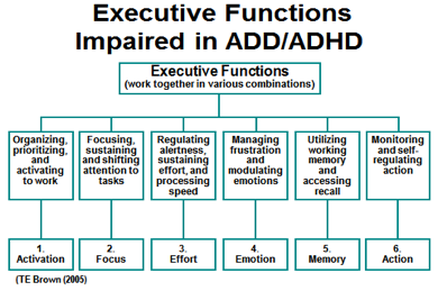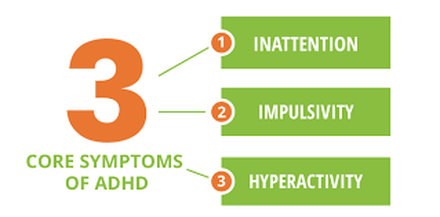"11 percent of American children, ages 4 to 17, have an attention disorder. That’s an increase of 42 percent in just eight years."
Attention-deficit/hyperactivity disorder (ADHD) is a brain disorder marked by an ongoing pattern of inattention and/or hyperactivity-impulsivity that interferes with functioning or development.
|
Inattention means a person wanders off task, lacks persistence, has difficulty sustaining focus, and is disorganized; and these problems are not due to defiance or lack of comprehension.
|
Hyperactivity means a person seems to move about constantly, including situations in which it is not appropriate when it is not appropriate, excessively fidgets, taps, or talks. In adults, it may be extreme restlessness or wearing others out with their activity.
|
Impulsivity means a person makes hasty actions that occur in the moment without first thinking about them and that may have high potential for harm; or a desire for immediate rewards or inability to delay gratification. An impulsive person may be socially intrusive and excessively interrupt others or make important decisions without considering the long-term consequences.
|
Signs and Symptoms
Inattention and hyperactivity/impulsivity are the key behaviors of ADHD. Some people with ADHD only have problems with one of the behaviors, while others have both inattention and hyperactivity-impulsivity.Most children have the combined type of ADHD.In preschool, the most common ADHD symptom is hyperactivity.
It is normal to have some inattention, unfocused motor activity and impulsivity, but for people with ADHD, these behaviors:
Inattention and hyperactivity/impulsivity are the key behaviors of ADHD. Some people with ADHD only have problems with one of the behaviors, while others have both inattention and hyperactivity-impulsivity.Most children have the combined type of ADHD.In preschool, the most common ADHD symptom is hyperactivity.
It is normal to have some inattention, unfocused motor activity and impulsivity, but for people with ADHD, these behaviors:
- are more severe
- occur more often
- interfere with or reduce the quality of how they functions socially, at school, or in a job
Medication
|
Stimulants
Stimulants are the most commonly prescribed medications for ADHD. They are often the first course of drugs used for ADHD treatment. You might hear this class of drugs called central nervous system (CNS) stimulant medications. They work by increasing the amounts of the hormones called dopamine and norepinephrine in the brain. This effect improves concentration and decreases the fatigue that’s common with ADHD. |
Non Stimulants
Non-stimulants affect the brain differently than stimulants do. These drugs also affect neurotransmitters, but they don’t increase dopamine levels. In general, it takes longer to see results from these drugs than from stimulants. These drugs come in several classes. A doctor might prescribe them when stimulants aren’t safe or are ineffective. They may also prescribe them if a person wants to avoid the side effects of stimulants. Healthline |
Video Resources
|
|
|
|
|
|


